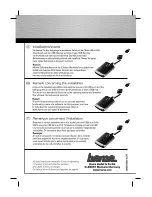
AT89RFD-11 User Guide
-5
7648A–USB–06/06
Section 3
Theory of Operation
3.1
Navigation
Technology
The heart of the optical navigation sensor is a CMOS image array. An LED and an opti-
cal system illuminate the surface that the sensor is navigating on. The texture of the
surface casts bright and dark spots forming distinct images as the sensor is moved
across the surface. A Digital Signal Processing (DSP) engine and its built-in algorithm
evaluate these images and determine the magnitude and direction of the movement.
The motion data is made available in the delta_X and delta_Y registers for the system
controller to retrieve. An extensive power saving topology is implemented within the
ADNS-3030 navigation engine. A Motion pin (output) is available to act as the system
interrupt. As long as there is no motion the system can remain in Sleep mode allowing
maximum battery power saving. Based on the last detected motion the optical naviga-
tion engine enters various power saving modes when no new motion occurs. These
power saving features are particularly beneficial for wireless.
Figure 3-1.







































